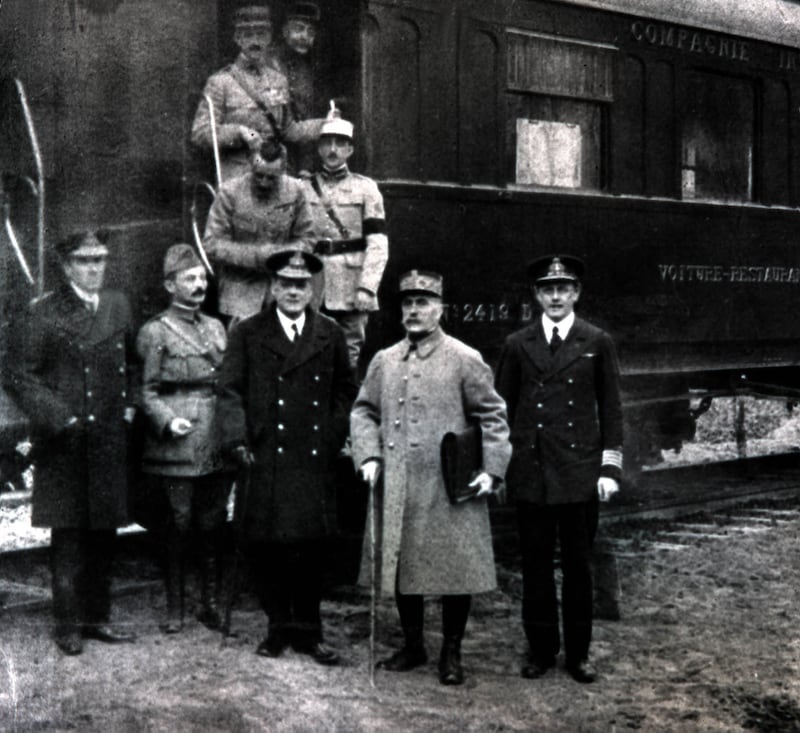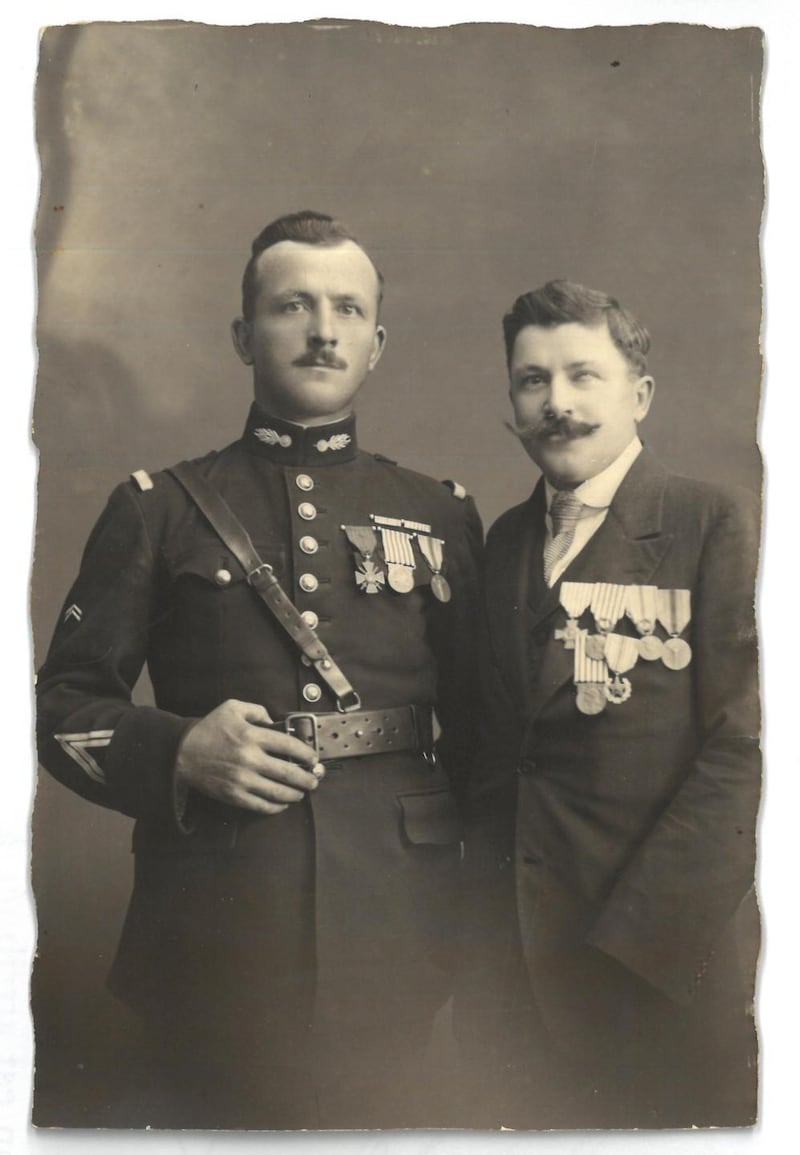The forest of Compiègne opens onto a desolate glade, blanketed by fog on a recent autumn morning. Workers were draining the soaked earth and covering it with gravel, so French and German leaders would not have to wear galoshes when they visit the place where the first World War ended 100 years ago.
"Here on the 11th of November 1918 the criminal pride of the German empire was vanquished by the free peoples they tried to enslave," reads the "sacred slab" at the centre of the clearing. The new plaque to be unveiled by French president Emmanuel Macron and German chancellor Angela Merkel on Saturday will doubtless be more fraternal.
A quotation from Winston Churchill hangs over the entry to the war museum, in French and in English: "A nation that forgets its past is doomed to repeat it."
Bernard Letemps, a retired engineer and reserve artillery officer, is president of the Association of the Armistice Memorial. Though he was born in 1945, the year the second World War ended, both wars have haunted Letemps's life. Europe's great achievement has been to prevent war for the past 73 years, he says. "That is a record on this continent. If it hadn't been for the wisdom of [Charles] de Gaulle and [German statesman Konrad] Adenauer, it would have started all over."
Letemps has been allotted 90 seconds to recount the events of November 8th-11th, 1918, to Macron and Merkel. He will tell them about two trains parked on parallel railway lines on opposite sides of the clearing, 150m apart, with a plank walkway spanning the mud between them.
The German delegation had stopped at field marshal Paul von Hindenburg’s headquarters in Spa, Belgium, on their way to Rethondes. As the counterpart of French marshal Ferdinand Foch, commander-in-chief of allied forces on the western front, Hindenburg should have led the delegation. “But Hindenburg washed his hands of it, like Pontius Pilate,” Letemps says.
Germany snapped all at once, like a spring wound too tightly
In his stead, Hindenburg dispatched Matthias Erzberger, a 43 year-old politician from the Catholic Centre Party, and minister without portfolio in the Berlin government, with the words, "Go with God and try to get as much as you can."
Marshal Foch refused to shake Erzberger’s hand, at the beginning and again at the end of the talks. There was nothing to negotiate, Foch said. He had lost a son and a son-in-law in the first year of the war. The Germans could take it or leave it.
While the 34 articles detailing the terms of the armistice were read out, Foch smoked cigars and tugged at his walrus-like moustache. British admiral Rosslyn Wemyss toyed with his monocle. When the French occupation of the Rhineland came up, a German naval captain called Vanselow shed tears.
Western front
Germany had lost 800,000 men in the previous four months. All along the western front, the Imperial German Army was being driven back. Red flags flew from buildings in Berlin as the country teetered on the brink of a Marxist revolution. As then captain Charles de Gaulle wrote, "Germany snapped all at once, like a spring wound too tightly."
Kaiser Wilhelm II abdicated on November 9th. Marshal Foch telegraphed von Hindenburg’s headquarters to make sure Erzberger still had the authority to sign the armistice.

French, British and Germans argued for an hour in the early hours of November 11th over the blockade, which Erzberger said was hurting women and children most. Admiral Wemyss interjected: "You didn't worry about women and children when you sank our ships."
When the final text was agreed, Erzberger insisted on adding his own addendum: “A people of 70 million suffers but does not die.” The German delegation left Rethondes when the armistice took effect at 11am.
The Nazi conspiracy theory, that the German army had been “stabbed in the back” by defeatist civilians, was born. Erzberger would be assassinated by former naval officers three years later.
"It has been signed", Georges Clemenceau's military adviser, Henri Mordacq told the French prime minister and minister of war when he burst into Clemenceau's Paris apartment at 6am on the morning of the 11th. Clemenceau, who was 77, had not slept. Over the previous year, the two men had visited poilus in mud-filled trenches and reorganised the military to make better use of aviation and Renault tanks. Clemenceau, "Le Tigre" and "Father Victory", wept speechlessly in Mordacq's arms.
At 11 am, Clemenceau ordered 1,200 canon volleys to signal the victory. He entered the national assembly that afternoon to a standing ovation. "All eyes filled with tears at the sight of this old man who, through this epic struggle, had embodied France, " Mordacq wrote.
We gave champagne to the wounded. Some of them will not survive, and it breaks my heart to look at them
Though it was clear the war was ending, Gen François Marjoulet had ordered his troops to pursue the retreating German army across the Meuse River in the Ardennes. “The enemy is hesitating to sign,” Marjoulet said. “You must strike at their morale, through an act of daring.” The last battle of the war continued absurdly for nearly six hours after the armistice was signed, until the end of hostilities at 11am. Dispatch rider Augustin Trébuchon was the last of 1.38 million French soldiers to die, shot in the forehead at 10.50 am.
A French bugler sounded the ceasefire at 11am. German buglers responded. Across the battlefield, men stood up in their foxholes, in bright sunshine. As recounted in Le Monde, thousands of voices, French and German, burst into La Marseillaise.
The army doctor Georges Duhamel and his wife Blanche, an actor, had written to each other every day they were separated by the war – 2,405 letters which are now kept at the Historial de la Grande Guerre in Péronne, in the Somme. A month after the armistice, Duhamel would win the prix Goncourt for his book Civilisation.
From his field surgery on the night of November 11th, Duhamel wrote: “It is over, my heart. Men have stopped massacring each other . . . This evening, the camp is lit up and the barracks are decorated with pine branches . . . Bells rang in all the villages. We gave champagne to the wounded. Some of them will not survive, and it breaks my heart to look at them.”
Foch’s statue
When the Wehrmacht invaded France in 1940, they were determined to erase every vestige of Germany's humiliation. Hitler demanded that France capitulate in the same railway car where Foch and Erzberger signed the 1918 armistice. "Then he razed the clearing, leaving only Foch's statue to look over the destruction, and he had the scene made into a postcard with the words 'The honour of the German army is restored,'" Bernard Letemps recounts.
The Historial at Péronne possesses one of the most complete collections of first World War uniforms, posters and artefacts. But none are as powerful as the firsthand testimony of Dominique Frère, who works at the museum.
At Rethondes and Péronne, I noticed that museum-goers were mostly older people. The young, it seems are no longer interested
As a child in the Somme, Frère remembers being frightened by old women in black who came out of their houses at sunset. “My grandfather told me they were in mourning their whole life. They could never remarry, because there were no men left.”
Frère, now 60, was 13 when his grandfather died. Louis Frère had been wounded on the first day of the terrible battle of the Chemins des Dames in in 1917, where France lost 100,000 men.

“My grandfather was in an assault tank, on the first day the French army used them,” Frère recounts. “The tank fell in a trench and my grandfather was ordered to dig it out. He heard machine-gun bullets pinging off the armour, and he thought he had only a few minutes to live. He felt something hot on his shoulder and lost consciousness. He woke up in hospital. He was never able to lift his left arm again. For years, bits of bone would work their way to the surface. During the second World War, a German doctor called Krug saved him when it got infected.”
Frère shows me a photograph of his father Louis and uncle Émile, in uniform with medals. Émile lost his left arm and left eye when he wrested a grenade from the hands of a child. Close to half of the 8,000,000 Frenchmen who fought in the first World War were wounded.
In 1944, the German Feldgendarmerie or military police was rounding up Frenchmen in the villages around Péronne, to send them to Germany as forced labour. Dominique Frère's father André, now 94, hid in the family's attic with two other youths.
The young men heard German boots on the stairs and thought they would be found. Then the German officer spotted a photograph of Louis Frère wearing his first World War medals. The officer stopped the search and sat in the kitchen with Frère for half an hour, discussing their experiences in the previous war, the three youths all the while listened from their hiding place.
At Rethondes and Péronne, I noticed that museum-goers were mostly older people. The young, it seems are no longer interested. The world marks the centenary of the end of the first World War as its memories and lessons recede as time marches on.







